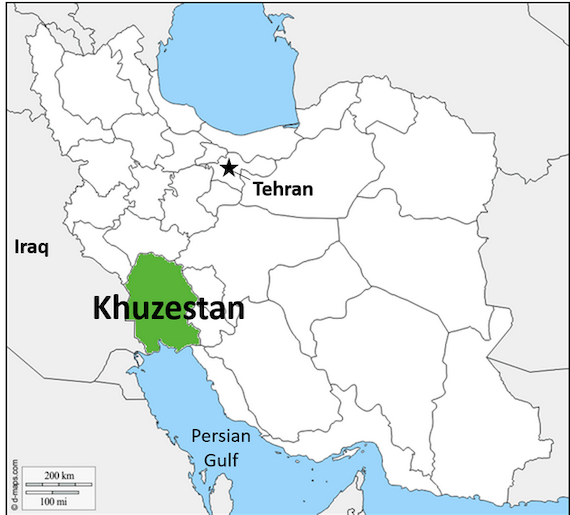Ann Arbor (Informed Comment) – Iran’s southwestern Khuzestan region, the center of its petroleum industry, has been wracked with protests for a week, in part over water shortages. Rallies have erupted in the towns of Mahshahr, Izeh, Ahvaz, Kut-e Abdollah, Susangerd, Aligoudarz and Shoushtar, according to Amnesty International
The Iranian government has sometimes replied to the unrest with live ammunition, drawing rebukes from rights organizations and from the United Nations. Some 8 protesters or innocent bystanders have been killed, says, AI, and at least one policeman.
This social unrest is a problem that will be inherited by incoming President Ebrahim Raisi, who has no background for dealing with it other than rounding dissenters up and hanging them.
Outgoing President Hassan Rouhani has insisted that people have the right to protest as long as they remain law-abiding. Even the hard line authoritarian, Ayatollah Ali Khamenei, Iran’s “August Leader,” has admitted that the protests are understandable according to AP, since water shortages in a hot, arid province like Khuzestan are a serious matter.
Rainfall is down 40% in 2021, and some streams have gone dry.
Sunday’s high in the province is 124° F., and Monday’s is forecast as 126° F. These are some of the hottest temperatures anywhere on earth and just below the all-time record temperature ever recorded, in Death Valley, Ca. Some 4.7 million people live in Khuzestan, out of Iran’s 83 million. With water shortages knocking out hydroelectric generation, the big city of Ahvaz has seen major power outages, which mean, no air conditioning.

h/t USIP Iran Primer.
Omid Shokry at The Atlantic Council observes that Iran is facing its driest summer in 50 years.
The climate crisis is drying out some regions of the world and increasing their average temperature significantly. M.Daneshvar, M. Ebrahimi and H. Nejadsoleymani write, “Among the Middle East countries, Iran will experience an increase of 2.6° C [4.6° F.] in mean temperatures and a 35% decline in precipitation in the next decades.”
These are some of the more ominous projections about climate for the entire Middle East region– that is, Iran is at the epicenter of the region’s climate crisis.
Garrett Nada at the US Institute for Peace Iran Primer observes that there are also serious problems with Iran’s water management in the region, with planning and ecological mistakes of Himalayan proportions having been made:
- “Since the 1970s, Iran has built more than a dozen dams in Khuzestan to manage seasonal flooding, generate hydroelectric power, irrigate crops and supply other provinces with water. Iran has since recognized that many dams have done more harm than good.
“We made these mistakes in the 1980s. Then we came to realize that in places that we’d built dams, we shouldn’t have built any, and in places where we should have built dams, we didn’t build any,” Isa Kalantari, the head of Iran’s Environment Department, said in 2018. Some of the dam reservoirs in Khuzestan are often empty. The have also caused or exacerbated environmental degradation. For example, the Gotvand Dam, completed in 2012, was built on salt beds that made the water in the reservoir unfit for irrigation.”
Shokry points out that some of this is karma. Iran is the world’s 7th-largest emitter of greenhouse gases and is committed to petroleum and natural gas. If the Biden administration can negotiate a return to the 2015 Iran nuclear deal, Iran has plans vastly to expand its fossil fuel production and export, which will only heat up and dry out the country even more. Like the US Republican Party, the Murdoch family’s Fox Cable News, and Saudi Arabia, Iran’s leaders are climate change deniers.
That denial, Tehran’s incompetence in water management, and Raisi’s inexperience and repressive instincts, all promise social turmoil.
—-
Bonus Video:
WION: “Violence escalates in water-shortage protests in Iran’s Khuzestan | Drought | ”




 © 2025 All Rights Reserved
© 2025 All Rights Reserved